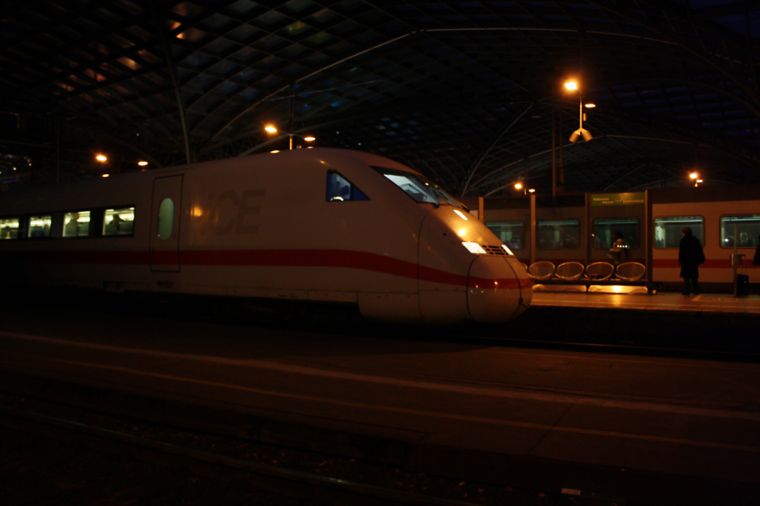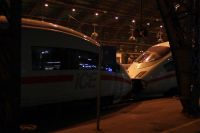ICE 2 Cab Car

Posted: 25 October 2008
| Taken: | 2008-10-25 00:19:05 |
|---|---|
| Camera: | Canon EOS 1000D |
| Exposure: | -2/1 |
| ISO: | 800 |
| Aperture: | f/3.5 |
| Exposure Time: | 1/13 |
| Focal Length: | 18 mm |

This work is licensed under a Creative Commons Germany license.
Notes
Unlike the ICE 3, the ICE 2 is a pure push-pull train, with all power in the powerhead at one end, and a cab car at the other. Rated at 250 kph (155 mph), it’s the fastest cab car allowed in Germany, although the train can go 280 (174 mph) instead when the powerhead is pulling. This does not matter at all on the line to Berlin, where this train is currently used, as that line is purely old tracks converted, and does not allow speeds of more than 200 kph (124 mph), which means that the ICE gets it’s faster travel times compared to a plain IC (such as seen in the background) only by stopping less.
The idea of the ICE 2 is that it’s half as long as an ICE 1, and you can couple two of them together very fast. This is used on a number of lines, where two trains start coupled together, then reach a certain station where they get split up, with one train going one route, the other a different one. On this line, the trains come from/to Berlin together and are divided in Hamm, from where one part continues on a longer route to Düsseldorf (and sometimes on to Cologne Trade Fair/Deutz), and the other follows a more direct route via Hagen and Wuppertal to Cologne. It’s the train I always use for most of the journey when going from Aachen to Goslar (and back, obviously).
A fun fact: The very same operating concept, i.e. train from Berlin, split in Hamm, one routed directly to Cologne via Hagen, one routed via Düsseldorf, was re-introduced with the ICE 2 in the nineties, but it was actually already used before the second world war. The Flying Hamburger trains (as in town, not McDonalds) used it already, although with far shorter trains, far lower top speeds and far less connections daily, on their Berlin-Rhein-Ruhr service, dubbed “Fliegender Kölner” (Flying Cologner).

 Deutsche Version
Deutsche Version Entire Gallery
Entire Gallery

 Next Picture
Next Picture
 Previous Picture
Previous Picture